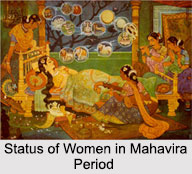 Status of Women in Mahavira Period enjoyed social and religious equality. Lord Mahavira strongly believed in equality for all human beings and was certainly advanced for his times. All women irrespective of class and creed were welcome as disciples without any discrimination. He set an example by translating his philosophy into practice and admitted men and women of all castes and creed impartially in his Four-Fold Sangha. The nuns inspired Sravakas to lead a religious life and helped them in their spiritual elevation. In return the Sravikas fulfilled all the nun`s requirements as part of the religious duties. In this period, young girls of high society of same aristocracy were generally well educated, skilled in music, dance and other forms of arts. There were no institutions for the princesses but a provision for private coaching was there. Comprehensive education was given by employing experienced, trained teachers who were specialized in their own subjects. This shows that female education was encouraged and appreciated.
Status of Women in Mahavira Period enjoyed social and religious equality. Lord Mahavira strongly believed in equality for all human beings and was certainly advanced for his times. All women irrespective of class and creed were welcome as disciples without any discrimination. He set an example by translating his philosophy into practice and admitted men and women of all castes and creed impartially in his Four-Fold Sangha. The nuns inspired Sravakas to lead a religious life and helped them in their spiritual elevation. In return the Sravikas fulfilled all the nun`s requirements as part of the religious duties. In this period, young girls of high society of same aristocracy were generally well educated, skilled in music, dance and other forms of arts. There were no institutions for the princesses but a provision for private coaching was there. Comprehensive education was given by employing experienced, trained teachers who were specialized in their own subjects. This shows that female education was encouraged and appreciated.
Women Disciples of Lord Mahavira
Lord Mahavira had many women disciples, Chandana being the first woman disciple and spiritual mother of the rest. There are references of women from Mahavira"s family who were all well educated and religiously devoted and included Trishala (mother), Yashoda (wife), Priyadarshini (daughter), Sudarshana (sister), Jyestha (elder brother"s wife) and Sesavati (grand-daughter). Yashoda sacrificed all her happiness and pleasures for her husband who could march on the path of renunciation instantly.
During this period, the women disciples of Lord Mahavira are as follows:
Dharini: The modest mother of Chandanbala, who preferred death instead of fulfilling the sex urge of a common military man. He tried to rape Dharini when she cut her tongue and invited death.
Mrugavati: She had denied proposal of remarriage and became a nun. She is well known for female chastity, political sagacity and heroism.
Shivadevi: A fire that was not getting extinguished by any means was put off by her, a chaste and virtuous woman by sprinkling water on it.
Bhadra: A great Sravika. She was Shalibhadra"s widowed mother who led her husband"s business in a full-fledged way. She also permitted her only son to become a monk and after that she led a religious life following the 12 vows of a Sravika.
Revati: A right hand Sravika of Lord Mahavira, possessed detailed knowledge of diseases and practicing medicine saved him from diarrhoea.
Jayanti: She used to attend discourses of Mahavira and discuss with him theological and metaphysical problems and became a devout nun.
Guna Sadhvi: She prepared the first copy of the allegorical work of Siddharshi, who called her the Goddess of learning.
Thus, during Mahavira period, women were respected, cajoled and cared for. Women were said to be blessed ones, virtuous, worthy of reverence and absolutely auspicious. Therefore, these nuns were on equal footing as monks and were granted full status of mendicancy.




















